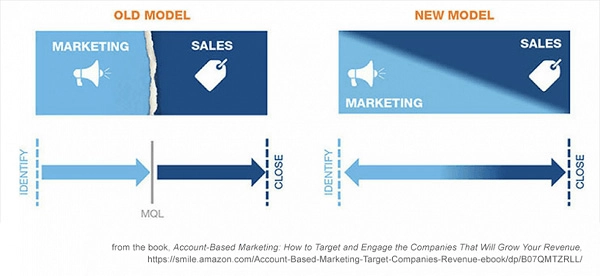
Introduction
For B2B marketers looking to boost their sales and revenue, Account-Based Marketing (ABM) is one of the most popular trends out there. It is gaining traction for a good reason too.
Here are some statistics that make the case for ABM:
So what makes ABM so attractive for B2B marketers?
This strategy can help you target specific buyers. This, in turn, can help you generate more high-quality leads and boost your sales. If you haven’t been making the most of Account-Based Marketing yet, it’s time to change that.
Still wondering if ABM services are worth your time and effort?
In this post, let’s take a look at how ABM can fill your sales pipeline like never before.
How Account-Based Marketing (ABM) Can Impact Your Sales Pipeline
Account-Based Marketing (ABM) is all toppling the traditional sales funnel as you know it.

Image via Proof
The first step is to identify high-value accounts and then focus your energy and efforts into converting them. This customer-first approach can make a huge impact on your overall sales pipeline.
Here is how it can help you build a better sales pipeline:
1. Your Sales and Marketing Teams Work in Alignment
When you deploy Account-Based Marketing (ABM) strategies to grow your business, one of the major changes is in the way your teams collaborate. Typically, marketing and sales teams work in silos even though there are multiple overlapping areas for them.

Image via KoMarketing
The ABM approach is to make them work in tandem to boost efficiency. Transparency is key so that both the teams are on the same page about generating a new lead and getting a conversion. The approach is designed in such a way that both the teams are focused on achieving the same goals.
In addition to this, both teams agree upon a mutual budget that needs to be dedicated to sales and marketing activities. Both the teams also understand the roles and responsibilities of each of them.
The biggest benefit of such alignment is that all interactions and communication remain consistent across the sales pipeline.
No matter for how long an account stays with you, all team members can see what the last conversation was about. So, it is easy for them to pick it up from the same point. This can go a long way in providing a seamless customer experience and boosting customer satisfaction.
2. You Can Understand Your Prospects’ Preferences
Compared to B2C buying cycles, B2B ones are much longer. That’s because prospects invest a lot of time in researching products as well as companies.
It is understandable because they are likely to be spending a sizable amount. Plus, multiple decision-makers and C-level executives may need to approve a decision before it is finalized. All in all, prospects may already have beyond the first stage of the funnel before they start talking to a salesperson.
This means that it is important to educate your prospects to move them along the sales pipeline. ABM emphasizes that marketers collect data to understand what their target audience likes and is looking for. It can help you make more informed choices by looking at data.
What’s more, you can use data-driven insights to formulate a better content strategy. You can create content that addresses common concerns and resonates with them. All in all, it can help you turn your prospects into paying customers.
3. You Can Identify High-Value Prospects
When your sales and marketing teams leverage data, they can identify high-value accounts that are likely to be interested in your products. Instead of broadcasting your message to a large audience, ABM is all about focused marketing.
Once you have identified these accounts, you can personalize your content and offers to appeal to them. Such customization can boost your relevance among these high-value accounts. That’s because you tailor your interactions. You can show them specific services or products based on the challenges they might be facing.
In a nutshell, ABM enables you to reach out in such a way that your products or services seem relevant and ideal for them.
4. You Can Deliver a Consistent Customer Experience
As we discussed above, ABM requires your team to work in tandem and take a 360 degree view of the buying cycle. This plays a major role in providing a consistent experience across channels and in different stages of the funnel.
For ABM to be effective, you always have to keep a long-term view in mind. After all, a prospect’s journey may last for several months or even years.
Through ABM, you can ensure that they are getting a unified experience even in the long-term. This is possible because ABM encourages sales and marketing teams to communicate and synchronize their efforts.
5. You Can Leverage Retargeting
It may take multiple touchpoints before you are finally able to qualify a prospect. Even if you have a lot of value to offer, you will have to be persistent in your efforts to make a sale.
When you are leveraging ABM, you get access to customer insights. This is a huge asset for your marketing campaigns.
You can leverage this data to retarget site visitors with social media ads or vice versa. The more they see your content, the better visibility you get.
You can also reach out to your prospects with the right content at the right time. Depending on the stage of the funnel they are in, you can showcase case studies, testimonials, whitepapers, webinars, eBooks, and other content.
This way you can reinforce your message across multi-channel points and also increase your chances of sending your prospects down the sales funnel.
6. You Can Measure Your Results
The biggest benefit of running ABM campaigns is that you can measure your impact. Through A/B testing, you can figure out which efforts are yielding results. Once you identify what isn’t working, you can actively work towards improving your strategy. If someone isn’t going your way, you can even make some adjustments on the fly.
Of course, you will need to track analytics and establish lead scoring mechanisms. Some of the key metrics that you should keep an eye on include site engagement, conversion rate, customer retention, and length of sales cycle.
When you follow these best practices for your ABM campaigns, you can build an effective sales pipeline.
Ready to Leverage Account-Based Marketing?
The focus of account-based marketing (ABM) strategies is to provide a more personalized and consistent experience to your prospects.
Through ABM campaigns, you can identify high-value accounts and tailor your messaging to give them a more relevant experience. Plus, you can measure the results of your campaign and change your strategy if required.
What’s more, you can also retarget ads to reinforce your messaging. All of this can make a huge impact on moving prospects along the funnel and creating a more effective sales pipeline.
Do you have any questions about leveraging ABM to build an effective sales pipeline? Please feel free to mention it in the comments section.
Our blog
Latest blog posts
Tool and strategies modern teams need to help their companies grow.

Our definition of marketing success in B2B is evolving. For years, traditional metric...

Video has emerged as one of the most effective tools to cut through the noise and con...

The way B2B buyers research, engage, and decide has changed and so must the way marke...







